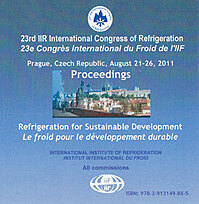
Document IIF
Transfert de chaleur et de masse dans le processus de dégivrage : un nouveau paradigme de modélisation.
Heat and mass transfer in the defrost process: a new modelling paradigm.
Numéro : pap. ID: 158
Auteurs : MOHS W. F., KULACKI F. A.
Résumé
An important problem in the refrigeration industry is the formation and removal of frost layers on surfaces of sub-freezing air coolers. Frost directly diminishes the performance and efficiency of the entire refrigeration system by presenting resistance to the air flow and heat transfer in the air cooler. To return the system to pre-frosted performance, the frost layer is removed through a defrost cycle. Current methods used for defrosting, namely applying heat directly to the frosted surface, are inherently inefficient. A majority of the applied heat is lost to the surrounding environment through convective and conductive heat transfer. While previous studies have investigated the defrost process, the majority of them have been experimental evaluations of defrost on the refrigeration system and air cooler. Only a few studies have attempted to describe analytically the fundamental heat and mass transfer processes of the frost melting process. The authors propose a new defrost model to describe the frost melting process at the surface level through all phases of the defrost cycle.
Documents disponibles
Format PDF
Pages : 8 p.
Disponible
Prix public
20 €
Prix membre*
Gratuit
* meilleur tarif applicable selon le type d'adhésion (voir le détail des avantages des adhésions individuelles et collectives)
Détails
- Titre original : Heat and mass transfer in the defrost process: a new modelling paradigm.
- Identifiant de la fiche : 30001581
- Langues : Anglais
- Source : Proceedings of the 23rd IIR International Congress of Refrigeration: Prague, Czech Republic, August 21-26, 2011. Overarching theme: Refrigeration for Sustainable Development.
- Date d'édition : 21/08/2011
Liens
Voir d'autres communications du même compte rendu (569)
Voir le compte rendu de la conférence
-
Frost properties on cold surface simple geometr...
- Auteurs : LEE Y. S., YOON S. H., HAYASE G., et al.
- Date : 07/06/2010
- Langues : Anglais
- Source : ACRA2010. Asian conference on refrigeration and air conditioning: Tokyo, Japan, June 7-9, 2010.
- Formats : PDF
Voir la fiche
-
Frost growth and densification on flat surfaces.
- Auteurs : CHEIKH A. el, JACOBI A.
- Date : 16/07/2012
- Langues : Anglais
- Source : 2012 Purdue Conferences. 14th International Refrigeration and Air-Conditioning Conference at Purdue.
- Formats : PDF
Voir la fiche
-
A model of hot-gas defrosting of evaporators. 1...
- Auteurs : KRAKOW K. I., YAN L., LIN S.
- Date : 1992
- Langues : Anglais
Voir la fiche
-
A model of hot-gas defrosting of evaporators. 2...
- Auteurs : KRAKOW K. I., YAN L., LIN S.
- Date : 1992
- Langues : Anglais
Voir la fiche
-
Unsteady heat and mass transfer during frost fo...
- Auteurs : LENIC K., TRP A., FRANKOVIC B.
- Date : 25/10/2006
- Langues : Anglais
- Source : Energija i okolis 2006. Medunarodni kongres: XX. znanstveni skup o energiji i zastiti ikolisa./ Energy and the environment 2006. International congress: 20th Scientific Conference on Energy and the Environment.
- Formats : PDF
Voir la fiche
